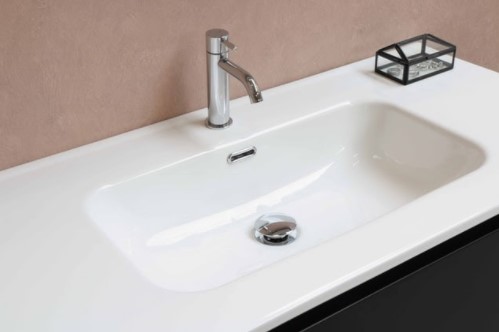
Pop-up sink drain stoppers offer a convenient way to fill or release water from your sink, but in the event of a clogged drain, they need to be removed before the problem can be addressed. In this post, the experts at SBPHA/C discuss how to unclog a pop up sink drain.
How Pop-up Sink Drains Work
A pop-up stopper is typically attached to a linkage mechanism underneath the faucet, which in turn is connected to a ball rod. This ball rod is what holds the stopper in place when it’s pushed down.
You’ll notice, however, that even when the plug is in its raised position to allow for drainage, the stopper makes it impossible to get tools like drain snakes into the drain. This means in the event of a clog, you’ll need to remove the pop-up stopper to gain access to the drain itself. In some cases, the stopper itself is the source of the clog––soap scum, toothpaste and hair can collect around the stopper plug, preventing drainage. It’s a good idea to remove and clean a pop-up stopper regularly to prevent this kind of build-up.
How to Remove a Pop-up Stopper
Sometimes, it’s possible to unlatch and remove a pop-up stopper from inside the sink. If you are unable to do so, you’ll likely need to adjust the mechanism underneath the sink.
Ensure your water is turned off and place a bucket or container under the sink to catch any drippings, then locate the horizontal pivot rod––this is the rod that holds the stopper in place. The pivot rod looks like a straight, thick piece of wire that inserts into the drainpipe.
Next, you’ll need to loosen the retaining nut on the back of your drainpipe, which keeps the pivot rod in place. The other end of the pivot rod is attached to a vertical strap––typically a flat piece of metal with holes in it. It’s a good idea to mark the position of the vertical strap along the pivot rod to make reinstallation easier. Unscrew or unclip the pivot rod from the vertical strap and pull the rod out. Once the pivot rod is removed, the stopper can be removed from the sink above.
Clean both the pivot rod and the stopper. The stopper can be soaked in warm water with a bit of vinegar, then lightly scrubbed with an old toothbrush. Use a drain snake or hair clog removal tool to remove any blockages from the drain itself and follow up with an appropriate drain cleaner if necessary.
To reassemble the parts, drop the stopper back in with the hole facing forward (this is where the pivot rod connects to the stopper). Insert the pivot rod, tighten the retaining nut and reattach the pivot rod to the vertical strap at the position you marked earlier.
Work with a Professional
If you continue to experience blockages or slow drainage, or if you aren’t comfortable taking any of these steps, it’s time to call a professional! SBPHA/C proudly serves Montgomery, Bucks, Philadelphia, Delaware or Chester County. Contact us or call 215-584-2098 today for all your plumbing, heating and air conditioning needs!
